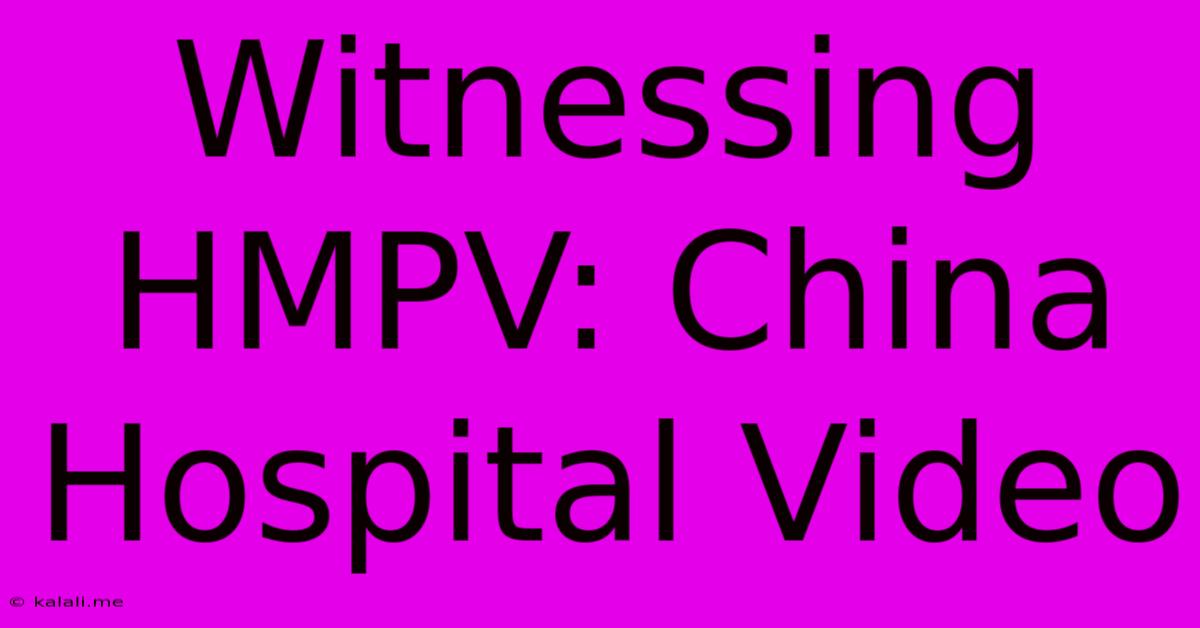Witnessing HMPV: China Hospital Video
Kalali
Jan 10, 2025 · 4 min read

Table of Contents
Witnessing HMPV: Decoding the Viral China Hospital Video and its Implications
The recent viral video depicting overflowing hospital wards in China, purportedly showing the impact of Human Metapneumovirus (HMPV), has sparked global concern and reignited discussions surrounding viral outbreaks and healthcare systems. While the video's authenticity is subject to verification and the scale of the outbreak remains debated, its emotional impact underscores the anxieties surrounding respiratory viruses and the vulnerability of healthcare infrastructures. This article delves deep into the video's implications, exploring the virus itself, its impact, and the broader context of public health preparedness.
Understanding Human Metapneumovirus (HMPV)
Human metapneumovirus (HMPV) is a common respiratory virus belonging to the Paramyxoviridae family. Similar to respiratory syncytial virus (RSV), it primarily infects the lower respiratory tract, causing symptoms ranging from mild cold-like illness to severe pneumonia, particularly in infants, young children, the elderly, and individuals with pre-existing health conditions.
Symptoms of HMPV Infection:
Symptoms typically appear 3-7 days after infection and include:
- Cough: Often a persistent and sometimes severe cough.
- Fever: Can range from mild to high.
- Runny nose: Usually accompanied by congestion.
- Sore throat: A common symptom, especially in older children and adults.
- Headache: Can be a significant symptom in some cases.
- Muscle aches: Generally mild to moderate.
- Shortness of breath: A more serious symptom, indicative of lower respiratory tract involvement.
- Wheezing: Suggests bronchiolitis or other lower respiratory tract inflammation.
Severe cases, especially in vulnerable populations, may require hospitalization due to pneumonia, bronchiolitis, or respiratory distress. These severe cases highlight the potential danger of HMPV, especially when healthcare resources are strained.
Transmission of HMPV:
HMPV spreads through close contact with infected individuals. The virus is transmitted via respiratory droplets produced when an infected person coughs or sneezes. Touching contaminated surfaces and then touching one's face can also lead to infection. This makes crowded environments, like hospitals during an outbreak, particularly susceptible to rapid spread. The China hospital video, if authentic, vividly illustrates this risk.
Analyzing the China Hospital Video: Fact vs. Fiction
The video's impact stems largely from its visual representation of a seemingly overwhelmed healthcare system. While the video's authenticity requires further verification through official channels, its viral spread highlights the public's anxiety surrounding viral outbreaks and the potential strain on healthcare resources.
Interpreting the Visuals:
The video, if genuine, presents a concerning picture of overcrowded hospital wards, potentially indicative of a surge in respiratory infections, likely including HMPV. The sheer number of patients and the apparent lack of readily available beds speak volumes about the potential strain on healthcare capacity. However, without official confirmation, it's crucial to approach the video with critical analysis, considering potential biases and limitations in the recording and its dissemination.
The Importance of Official Verification:
The absence of official confirmation about the video's context and the exact number of HMPV cases depicted necessitates caution. It is crucial to rely on verified information from official health authorities and reputable news sources. Misinformation spreads rapidly online, and it is essential to differentiate between credible reports and unsubstantiated claims.
Broader Implications: Healthcare Preparedness and Public Health
The video, regardless of its complete veracity, serves as a stark reminder of the importance of robust public health infrastructure and preparedness. The potential for rapid spread of respiratory viruses like HMPV, especially in densely populated areas, underscores the need for:
- Improved surveillance systems: Effective monitoring and rapid detection of outbreaks are crucial to timely intervention.
- Enhanced healthcare capacity: Investment in healthcare infrastructure and resources is vital to manage surges in patient numbers.
- Effective communication strategies: Clear and timely communication with the public builds trust and facilitates appropriate responses.
- Vaccination and preventative measures: Research into HMPV vaccines and the promotion of preventative measures, such as hand hygiene and respiratory etiquette, are crucial.
Conclusion: Learning from the Viral Video
The China hospital video, whether fully accurate or not, serves as a powerful symbol of the vulnerabilities inherent in healthcare systems faced with viral outbreaks. It highlights the critical need for continuous investment in public health infrastructure, robust surveillance mechanisms, and effective communication strategies. The potential impact of respiratory viruses like HMPV should prompt governments and healthcare systems globally to strengthen their preparedness and response capabilities. Further investigation and confirmation of the video's details are necessary, but the underlying message remains: proactive measures are crucial to prevent future healthcare crises. Learning from this event—be it a real depiction of strain or a symbolic warning—is vital for ensuring a more resilient healthcare future for all.
Latest Posts
Latest Posts
-
Cubic Feet In A 5 Gallon Bucket
Jul 12, 2025
-
How Many Tablespoons Is 3 4 Oz
Jul 12, 2025
-
Visions Of Blank Danced In Their Heads
Jul 12, 2025
-
How Many Cups Is 3 Quarts Water
Jul 12, 2025
-
How Many Feet Is In A Half Acre
Jul 12, 2025
Related Post
Thank you for visiting our website which covers about Witnessing HMPV: China Hospital Video . We hope the information provided has been useful to you. Feel free to contact us if you have any questions or need further assistance. See you next time and don't miss to bookmark.